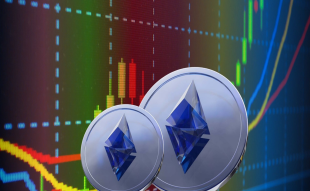Join Our Telegram channel to stay up to date on breaking news coverage
Ethereum’s revolutionary potential will be unleashed as it evolves and disrupts the financial landscape. Ethereum’s innovative contract capabilities and decentralized apps have proven their ability to empower developers and entrepreneurs.
As the crypto space expands, new contenders are emerging, challenging Ethereum’s dominance. In contrast to Ethereum’s high transaction fees and network congestion, these hidden gems offer scalability and interoperability. Seeing how Ethereum adapts and responds as the competition heats up will be fascinating.
Currently, Ethereum is trading for $1,862.51 USD, with a 24-hour volume of $4.745 billion. Over the last 24 hours, Ethereum’s price has decreased by 0.33%. Last week, Ethereum fell by 4.47% last week, but it grew by 3.92% over the past month.
Ethereum Stats:
- Today’s price – is $1862.51
- Market cap – $22.829 Billion
- Circulating supply – 120,208,383 ETH
- Total supply – 120,208,383 ETH
- Coinmarketcap ranking – 2

Price Potential: Unlocking Ethereum’s Value if Resistance is Overcome
Ethereum stands out in the third quarter of 2023 as a dynamic force in crypto. Ethereum’s value hovers around $2,000, so it’s on the verge of a significant milestone. The crypto community’s interest and confidence in Ethereum are palpable, igniting excitement among enthusiasts and investors.
Ethereum’s current trading price of $1862.51 shows promise, but it faces resistance. Breaking through $1959.46 may be challenging, but it’s a gateway to exponential growth. Ethereum’s future trajectory could be defined by $2021.35, a key level.

Ethereum’s future depends on breaking $1959.46, which could push its value to $1960 or $1990. Observing the market’s fluctuations will give you insights into potential shifts.
However, a price decline is possible if Ethereum doesn’t get over the resistance. In these circumstances, $1844.26 and $1820.70 might act as pillars of stability. Monitoring market dynamics will shed light on Ethereum’s progress and how it’s affected.
Unleashing Ethereum: Exploring a Realm of Infinite Possibilities
Within the Ethereum blockchain lies an extraordinary world brimming with endless possibilities. In this story, smart contracts weave a tapestry of innovation, redefining entire industries.
Individuals can harness the transformative power at their fingertips in this ethereal domain. Ethereum is a majestic titan in this landscape, inviting pioneers to carve their own paths and discover new frontiers.
Ethereum is one of the biggest names in blockchain technology. It was created in 2015 and brought smart contracts to the forefront. As well as that, Ethereum introduced a wide range of decentralized applications (DApps).
Ethereum has become the foundation for numerous groundbreaking projects thanks to its active community, creative environment, and ambitious goals. The Ethereum blockchain has the potential to revolutionize industries and empower people, as we’ll discover in this article.
In late 2013, Vitalik Buterin released the Ethereum White Paper, outlining his vision for a decentralized blockchain platform supporting smart contracts and DApps.
The Ethereum Foundation was founded in 2014 to promote and develop Ethereum. Funds were raised for its development through an Ether presale. The Frontier version of Ethereum launched in 2015, followed by Homestead in 2016. Due to the DAO hack, Ethereum had to fork hard, resulting in Ethereum and Ethereum Classic.
The platform got better with upgrades like Metropolis. Ethereum 2.0 boosts scalability and sustainability with proof-of-stake and shard chains. With ongoing innovation and a promising future, Ethereum thrives today.
Ethereum: Redefining Transactions and Trust with Smart Contracts and DApps
The Ethereum blockchain platform allows you to create and execute smart contracts. Developers can build decentralized applications (DApps) in a programmable environment. In 2013, Vitalik Buterin wrote the Ethereum White Paper, introducing the platform’s vision of a global, open-source system that eliminates the need for intermediaries in smart contract transactions, promoting trust, security, and transparency.
Ethereum’s smart contracts revolutionized parties’ interaction by enabling direct, automated agreements without middlemen.
The self-executing contracts ensure accuracy and efficiency in areas like finance, supply chain, and real estate. The Ethereum Virtual Machine (EVM) runs smart contracts, a decentralized runtime environment that lets developers write code in different programming languages.
Due to this flexibility, Ethereum has developed a thriving ecosystem of DApps, expanding its potential impact.
DApps that harness smart contracts can be developed and used on Ethereum’s blockchain. Decentralized networks ensure transparency, immutability, and resistance to censorship. DeFi protocols, NFT marketplaces, decentralized exchanges, and gaming platforms are all DApps.
Ethereum’s native cryptocurrency, Ether (ETH), is the fuel that drives the network and facilitates economic transactions in DApps. Ethereum uses it for transaction fees, staking, and investment.
Empowering Efficiency: Ethereum’s Journey towards a Faster, Greener Blockchain
Ethereum is addressing scalability concerns to keep up with the growing transaction demand. Ethereum 2.0 is a significant upgrade that switches from proof-of-work to proof-of-stake consensus.
By making this switch, you’ll improve scalability, reduce energy consumption, and make the network more eco-friendly.
Furthermore, the community is exploring Layer 2 scaling solutions like Optimistic Rollups and Zk-Rollups. While maintaining Ethereum’s decentralization, these advancements provide fast, affordable, and secure experiences.
Ethereum is a blockchain platform that runs smart contracts. Using the Ethereum Virtual Machine (EVM), smart contracts that execute automatically and are enforceable can be executed. Ethereum is a distributed ledger maintained by a network of computers (nodes), and miners validate transactions and smart contracts.
Proof-of-stake (PoS) is Ethereum’s consensus mechanism that ensures network security. DeFi, NFTs, and supply chain management are all applications of Ethereum.
Ethereum: Building the Future of Decentralization and Innovation
Ethereum’s popularity and success can be attributed to several key benefits. The first thing Ethereum introduced was smart contracts, which automated agreements and eliminated middlemen. Second, its decentralized nature ensures transparency, resilience, and censorship resistance.
The flexibility and programmability of Ethereum make it an excellent platform for developing decentralized applications (DApps). Moreover, Ethereum fosters interoperability, allowing seamless integration between projects. Innovation and development are driven by its vibrant ecosystem.
EIPs (Ethereum Improvement Proposals) encourage ongoing protocol improvements. Ethereum’s programmability has led to decentralized finance and non-fungible tokens.
These advantages have made Ethereum a leading blockchain platform, promoting innovation, decentralization, and mainstream adoption.
Ethereum has changed the game for decentralized apps. It has great features, a great community, and a strong foundation. People and companies can transform industries with Ethereum, from finance to supply chains. Innovation and empowerment are endless with this platform.
Ethereum lets people make their digital assets and tokens, making ICOs and raising capital easier. Developers can also build decentralized applications on Ethereum, which can power various services. Developers and entrepreneurs now have all kinds of new options
Alternative Ethereum
DeeLance: Transforming Freelancing through Blockchain Innovation

The DeeLance platform harnesses the power of blockchain to revolutionize freelancing. Using blockchain, DeeLance brings transparency, security, and cost savings to the forefront. It fosters trust and reliability for freelancers and clients.
DeeLance takes freelancing to new heights with its interactive interface. There are themed rooms and immersive exhibitions where freelancers and clients can connect. The Metaverse revolutionizes remote work and business.
DeeLance has a unique creative twist. Using NFTs (Non-Fungible Tokens), DeeLance ensures ownership, royalty collection, and reputation. Everyone benefits from this approach because it fosters trust and transparency.
For freelancers, DeeLance is perfect. Freelancers and clients can shape their careers with DLANCE tokens. Among the features of the DeeLance app are virtual offices, talent hiring, work promotion, and client collaboration.
With its presale, DeeLance has already raised $1.508 million. With a presale token price of $0.043 and going up to $0.048, the project’s target is $2.3 million. The listing price for the tokens is 0.04 USDT.
Also Read:
- Ethereum Name Service Price Prediction for Today, July 8: ENS/USD Heads to the Upside; Price Shoots Above $9.0 Level
- As Ethereum Struggles to Break $2,000, Wall Street Memes Fundraise Powers Past $13 Million – Time to Buy WSM?
- 10+ Best Meme Coins to Buy
Join Our Telegram channel to stay up to date on breaking news coverage


